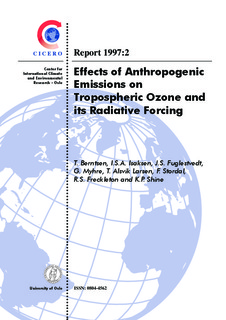| dc.description.abstract | Tropospheric ozone changes since pre-industrial times due to changes in emissions have been calculated by the University of Oslo global 3-D photochemical model. The radiative forcing caused by the increase in ozone has been calculated by two independent radiative transfer models; the University of Reading model (Reading), and the University of Oslo/NILU model (OsloRad). Significant increases in upper tropospheric ozone concentrations are found at northern mid-latitudes (15-40 ppbv, depending on season) at about 10 km altitude. In the tropical regions, the largest increase (about 20 ppbv for all seasons) is found at about 15 km altitude. The increase is found to be caused mainly by enhanced in-situ production due to transport of precursors from the boundary layer, with a smaller contribution from increased transport of ozone produced in the boundary layer. The lifetime of ozone in the troposphere decreased by about 35 % due to enhanced concentrations of HO2. The calculated increase in surface ozone in Europe is found to be in good agreement with observations. The calculations of radiative forcing include the effect of clouds and allow for thermal adjustment in the stratosphere. The global and annual averaged radiative forcing at the tropopause from both models (0.28 W/m2 and 0.26 W/m2, for the OsloRad and Reading models respectively) are in the lower part of the estimated range given in IPCC (1995). The calculated radiative forcing is similar in magnitude to the negative radiative forcing by sulphate aerosols, but displaced southward in source regions at northern mid-latitudes. The increase in tropospheric ozone is calculated to have cooled the lower stratosphere by up to 0.9 K, with possibly half of this cooling occuring in the past two to three decades. | nb_NO |
